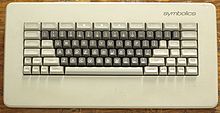| This article needs to be updated. Please help update this article to reflect recent events or newly available information. (June 2020) |

The Meta key is a modifier key on certain keyboards. It first appeared on the Stanford Artificial Intelligence Lab (SAIL) keyboard in 1970.
History
The Meta key first appeared on the Stanford Artificial Intelligence Lab (SAIL) keyboard in 1970 and successors such as the Knight keyboard, space-cadet keyboard, MIT Lisp machine, Symbolics keyboards, and on Sun Microsystems keyboards (where it is marked with a black diamond "◆").
Use
| This section does not cite any sources. Please help improve this section by adding citations to reliable sources. Unsourced material may be challenged and removed. (December 2020) (Learn how and when to remove this message) |
Generally, the Meta key worked similar to Macintosh's Command key, in that when held down it modified letters and symbols into immediate commands (shortcuts). On these keyboards the Control key was placed closest to the space bar, then the Meta key outside Control. The space-cadet keyboard added the Super key outside Meta, and the Hyper key outside that. All these keys produced shortcuts (2-1 of them for every letter), but the Control ones were easiest to type and most popular, and the Meta ones second-easiest and thus second most popular. However, on most modern keyboards, the Control key is farthest from the space bar, reversing the convenience of shortcuts.
On keyboards that lack a physical Meta key, its functionality may be invoked by other keys such as the Windows key or Macintosh's Option key. However, software often provides another workaround, such as using the Alt key (which does not exist on the Knight keyboard), or using the Esc key as a prefix (e.g., in Emacs). Because of these workarounds, the need for Meta – despite being the most-used additional modifier key – was less than for other modifier keys. It is more common today to use the Windows key to emulate the Super key.
Gallery
See also
References
- "SAIL Keyboard".
- Raymond, Eric S.; Steele, Guy L. (1996). The New Hacker's Dictionary. MIT Press. p. 420. ISBN 9780262680929.
- "Change Profiles Keyboard preferences in Terminal on Mac". Apple Support. Retrieved 2022-04-02.
| Keyboard keys | |
|---|---|
| Dead keys | |
| Modifier keys | |
| Lock keys | |
| Navigation keys | |
| Editing | |
| Contextual | |
| Misc. | |

